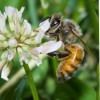 Protecting honey bees and other pollinators from pesticide impacts is important to the sustainability of agriculture. Consequently, pesticide applicators must determine if there is a clear hazard to managed or wild populations of bees. Potential exposure of bees to pesticides can vary greatly depending on the type of pesticide, formulation, application method, label restrictions, and other factors. The goal in using a pesticide is to achieve maximum benefit (success) with minimum negative impact, and these factors should always be considered in pesticide selection. This publication is written (1) to help assure the sustainability of both bees and agriculture by informing beekeepers, pesticide users, and the general public about the often complex relationship between pollinators (specifically bees) and pesticides, (2) to offer guidance for improved communication between beekeepers and pesticide users, (3) to offer pollinator risk-reducing strategies for growers and other applicators when using pesticides, and (4) to provide clarity in laws, labeling, and associated definitions. This 14-page fact sheet was written by J. D. Ellis, J. Klopchin, E. Buss, F. M. Fishel, W. H. Kern, C. Mannion, E. McAvoy, L. S. Osborne, M. Rogers, M. Sanford, H. Smith, P. Stansly, L. Stelinski, and S. Webb, and published by the UF Department of Entomology and Nematology, March 2014.
Protecting honey bees and other pollinators from pesticide impacts is important to the sustainability of agriculture. Consequently, pesticide applicators must determine if there is a clear hazard to managed or wild populations of bees. Potential exposure of bees to pesticides can vary greatly depending on the type of pesticide, formulation, application method, label restrictions, and other factors. The goal in using a pesticide is to achieve maximum benefit (success) with minimum negative impact, and these factors should always be considered in pesticide selection. This publication is written (1) to help assure the sustainability of both bees and agriculture by informing beekeepers, pesticide users, and the general public about the often complex relationship between pollinators (specifically bees) and pesticides, (2) to offer guidance for improved communication between beekeepers and pesticide users, (3) to offer pollinator risk-reducing strategies for growers and other applicators when using pesticides, and (4) to provide clarity in laws, labeling, and associated definitions. This 14-page fact sheet was written by J. D. Ellis, J. Klopchin, E. Buss, F. M. Fishel, W. H. Kern, C. Mannion, E. McAvoy, L. S. Osborne, M. Rogers, M. Sanford, H. Smith, P. Stansly, L. Stelinski, and S. Webb, and published by the UF Department of Entomology and Nematology, March 2014.
http://edis.ifas.ufl.edu/in1027
Category: Pesticide Information
Pesticide Applicator Certification and Training
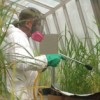 Certification is a process that allows a person to qualify to use pesticides in the course of his or her occupation. In Florida, the Florida Department of Agriculture and Consumer Services (FDACS) administers the certification process. Training provides instruction on proper pesticide use and handling to individuals who want to obtain or retain certification. In Florida, UF/IFAS Extension primarily conducts pesticide training, but other associations, industry, non-profit organizations, private companies, and federal and state government agencies also provide and assist with training. This 3-page fact sheet was written by F. M. Fishel, and published by the UF Department of Agronomy, October 2013.
Certification is a process that allows a person to qualify to use pesticides in the course of his or her occupation. In Florida, the Florida Department of Agriculture and Consumer Services (FDACS) administers the certification process. Training provides instruction on proper pesticide use and handling to individuals who want to obtain or retain certification. In Florida, UF/IFAS Extension primarily conducts pesticide training, but other associations, industry, non-profit organizations, private companies, and federal and state government agencies also provide and assist with training. This 3-page fact sheet was written by F. M. Fishel, and published by the UF Department of Agronomy, October 2013.
http://edis.ifas.ufl.edu/pi247
Calibration of Chemical Applicators Used in Vegetables (HS1220)
 Calibration is the process used to determine the amount of chemical material applied per unit area. Equipment for applying liquid and dry materials must be accurately calibrated for pesticides to work efficiently and to avoid crop injury or death. The pesticide label is a legal document and must be followed. Properly calibrating equipment ensures the product is being applied as specified on the label and that environmental contamination will be minimized. This 6-page fact sheet discusses some methods for calibration of sprayers and dry material spreaders and includes information about calibration to help growers properly apply pesticides. written by M. R. Miller and P. J. Dittmar, and published by the UF Department of Horticultural Sciences, May 2013.
Calibration is the process used to determine the amount of chemical material applied per unit area. Equipment for applying liquid and dry materials must be accurately calibrated for pesticides to work efficiently and to avoid crop injury or death. The pesticide label is a legal document and must be followed. Properly calibrating equipment ensures the product is being applied as specified on the label and that environmental contamination will be minimized. This 6-page fact sheet discusses some methods for calibration of sprayers and dry material spreaders and includes information about calibration to help growers properly apply pesticides. written by M. R. Miller and P. J. Dittmar, and published by the UF Department of Horticultural Sciences, May 2013.
http://edis.ifas.ufl.edu/hs1220
Factors Affecting Herbicide Use in Fruits and Vegetables (HS1219)
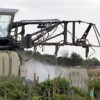 Proper herbicide application is critical for fruit and vegetable growers to effectively manage weeds. Improper herbicide application may lead to herbicide loss from the targeted area, increased crop injury, and reduced weed control. Growers need to take into account a number of factors before and during application in any crop to ensure the herbicide is effective. Herbicide efficacy is greatly affected by timing and environmental conditions. Although complete weed control is not always possible, even slight reductions in weed populations can greatly enhance productivity in fruit and vegetable crops. This 4-page fact sheet reviews techniques and processes to help growers properly apply herbicides. Understanding the processes and applying the following techniques will help to increase the overall efficacy of herbicides in fruit and vegetable production. Written by C. E. Rouse and P. J. Dittmar, and published by the UF Department of Horticultural Sciences, May 2013.
Proper herbicide application is critical for fruit and vegetable growers to effectively manage weeds. Improper herbicide application may lead to herbicide loss from the targeted area, increased crop injury, and reduced weed control. Growers need to take into account a number of factors before and during application in any crop to ensure the herbicide is effective. Herbicide efficacy is greatly affected by timing and environmental conditions. Although complete weed control is not always possible, even slight reductions in weed populations can greatly enhance productivity in fruit and vegetable crops. This 4-page fact sheet reviews techniques and processes to help growers properly apply herbicides. Understanding the processes and applying the following techniques will help to increase the overall efficacy of herbicides in fruit and vegetable production. Written by C. E. Rouse and P. J. Dittmar, and published by the UF Department of Horticultural Sciences, May 2013.
http://edis.ifas.ufl.edu/hs1219
The Importance of Keeping Pesticide Records (PI246)
 Keeping accurate records of pesticide use makes good sense. In some cases, you are required by law to maintain records on pesticide use, but having records available can also help you improve your operation. This 8-page fact sheet outlines who is required to keep records of pesticide use and the appropriate contents. Written by F. M. Fishel, and published by the UF Department of Agronomy, May 2013.
Keeping accurate records of pesticide use makes good sense. In some cases, you are required by law to maintain records on pesticide use, but having records available can also help you improve your operation. This 8-page fact sheet outlines who is required to keep records of pesticide use and the appropriate contents. Written by F. M. Fishel, and published by the UF Department of Agronomy, May 2013.
http://edis.ifas.ufl.edu/pi246
Water Quality and the Effectiveness of Pesticides (PI245)
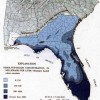 Pesticide applicators do not usually blame the mix for a pest control failure. Rather, the applicator will check if the correct pesticide was chosen for the job, if the pest was misidentified, if application equipment was properly calibrated, or if there was pesticide resistance. However, pesticide applicators should be aware that water quality can play a role in the efficacy of a pesticide treatment. Some pesticides lose their effectiveness when mixed with water that contains suspended or dissolved solids. This publication discusses how water quality affects pesticide mixes. This 2-page fact sheet was written by F. M. Fishel, and published by the UF Department of Agronomy, April 2013.
Pesticide applicators do not usually blame the mix for a pest control failure. Rather, the applicator will check if the correct pesticide was chosen for the job, if the pest was misidentified, if application equipment was properly calibrated, or if there was pesticide resistance. However, pesticide applicators should be aware that water quality can play a role in the efficacy of a pesticide treatment. Some pesticides lose their effectiveness when mixed with water that contains suspended or dissolved solids. This publication discusses how water quality affects pesticide mixes. This 2-page fact sheet was written by F. M. Fishel, and published by the UF Department of Agronomy, April 2013.
http://edis.ifas.ufl.edu/pi245
The EPA Conventional Reduced Risk Pesticide Program (PI224)
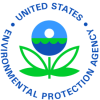 The Food Quality Protection Act (FQPA) of 1996 initiated the U.S. Environmental Protection Agency’s (EPA) Conventional Reduced Risk Pesticide Program. Its purpose is to expedite the review and registration process of conventional pesticides that pose less risk to human health and the environment than existing conventional alternatives. Riskier conventional alternatives are those pesticides EPA deems as having neurotoxic, carcinogenic, reproductive, and developmental toxicity, or groundwater contamination effects. It serves as a means to ensure that reduced risk pesticides enter the channels of trade and are available to growers as soon as possible. This 11-page fact sheet was written by F.M. Fishel, and published by the UF Department of Agronomy, April 2013.
The Food Quality Protection Act (FQPA) of 1996 initiated the U.S. Environmental Protection Agency’s (EPA) Conventional Reduced Risk Pesticide Program. Its purpose is to expedite the review and registration process of conventional pesticides that pose less risk to human health and the environment than existing conventional alternatives. Riskier conventional alternatives are those pesticides EPA deems as having neurotoxic, carcinogenic, reproductive, and developmental toxicity, or groundwater contamination effects. It serves as a means to ensure that reduced risk pesticides enter the channels of trade and are available to growers as soon as possible. This 11-page fact sheet was written by F.M. Fishel, and published by the UF Department of Agronomy, April 2013.
http://edis.ifas.ufl.edu/pi224
Storage Limitation Statements: Temperature – Herbicides (PI123/PI160)
 This 8-page guide provides information about how temperature affects storage of agricultural herbicides. A table is included that lists many common agricultural herbicides registered for use in Florida, with storage limitation statements. Written by Frederick M. Fishel, and published by the UF Department of Agronomy, April 2013.
This 8-page guide provides information about how temperature affects storage of agricultural herbicides. A table is included that lists many common agricultural herbicides registered for use in Florida, with storage limitation statements. Written by Frederick M. Fishel, and published by the UF Department of Agronomy, April 2013.
http://edis.ifas.ufl.edu/pi160
Reducing Fumigant Application Rates and Soil Emissions with Plastic Mulch Technology (ENY046/IN403)
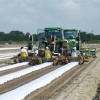 With the new fumigant regulations and rising cost of crop production, including fumigants, it would be desirable to reduce the standard use rate of soil fumigants. The use of higher-barrier, gas-impermeable mulches may make it possible to reduce fumigant application rates by helping to contain the fumigant longer within the soil and reduce overall emissions into the atmosphere. The results of field studies show that fumigant application rates can be reduced by 20 to as much as 40% through the use of virtually impermeable or the more gas-tight TIF mulch films at the time of application. This 5-page fact sheet was written by J. W. Noling, and published by the UF Department of Entomology and Nematology, March 2013.
With the new fumigant regulations and rising cost of crop production, including fumigants, it would be desirable to reduce the standard use rate of soil fumigants. The use of higher-barrier, gas-impermeable mulches may make it possible to reduce fumigant application rates by helping to contain the fumigant longer within the soil and reduce overall emissions into the atmosphere. The results of field studies show that fumigant application rates can be reduced by 20 to as much as 40% through the use of virtually impermeable or the more gas-tight TIF mulch films at the time of application. This 5-page fact sheet was written by J. W. Noling, and published by the UF Department of Entomology and Nematology, March 2013.
http://edis.ifas.ufl.edu/in403
Storage Limitation Statements: Temperature – Fungicides (PI122/PI159)
 This 7-page fact sheet provides information about how temperature affects storage of agricultural fungicides. A table is included that lists many common agricultural fungicides registered for use in Florida along with storage limitations. was written by Frederick M. Fishel, and published by the UF Department of Agronomy, March 2013.
This 7-page fact sheet provides information about how temperature affects storage of agricultural fungicides. A table is included that lists many common agricultural fungicides registered for use in Florida along with storage limitations. was written by Frederick M. Fishel, and published by the UF Department of Agronomy, March 2013.
http://edis.ifas.ufl.edu/pi159
Fumigant Nematicides Registered for Vegetable Crop Use in Florida (ENY064/IN980)
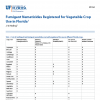 This 3-page fact sheet lists of multispectrum fumigant nematicides currently registered for use on different Florida crops (Table 1); their maximum rates and specific details for field application (Table 2); and a generalized summary of maximum use rate and relative effectiveness of various soil fumigants for nematode, soilborne disease, and weed control in Florida (Table 3). Written by J. W. Noling, and published by the UF Department of Entomology and Nematology, January 2013.
This 3-page fact sheet lists of multispectrum fumigant nematicides currently registered for use on different Florida crops (Table 1); their maximum rates and specific details for field application (Table 2); and a generalized summary of maximum use rate and relative effectiveness of various soil fumigants for nematode, soilborne disease, and weed control in Florida (Table 3). Written by J. W. Noling, and published by the UF Department of Entomology and Nematology, January 2013.
http://edis.ifas.ufl.edu/in980
Is Our Food Safe from Pesticides? (PI230)
 Growers of the food supply have adopted the use of integrated pest management (IPM) because it is no longer possible to rely solely on chemical pesticides to prevent unacceptable crop losses. According to the U.S. Environmental Protection Agency (EPA), IPM is the coordinated use of pest and environmental information and available pest control methods to prevent unacceptable levels of damage by the most economical means with the least possible hazard to people, property, and the environment. Scientific IPM strategies give the grower economic incentives for sustaining long-term crop protection with minimal disruption to the environment. The agricultural community typically will use pesticides sparingly as part of the IPM strategy whenever proven alternatives are not available for pest control. This 4-page fact sheet was written by Frederick M. Fishel, and published by the UF Department of Agronomy, March 2013.
Growers of the food supply have adopted the use of integrated pest management (IPM) because it is no longer possible to rely solely on chemical pesticides to prevent unacceptable crop losses. According to the U.S. Environmental Protection Agency (EPA), IPM is the coordinated use of pest and environmental information and available pest control methods to prevent unacceptable levels of damage by the most economical means with the least possible hazard to people, property, and the environment. Scientific IPM strategies give the grower economic incentives for sustaining long-term crop protection with minimal disruption to the environment. The agricultural community typically will use pesticides sparingly as part of the IPM strategy whenever proven alternatives are not available for pest control. This 4-page fact sheet was written by Frederick M. Fishel, and published by the UF Department of Agronomy, March 2013.
http://edis.ifas.ufl.edu/pi230
EPA’s Endocrine Disruptor Screening Program (EDSP) (PI227)
 People have asked questions in recent years concerning the effects that certain chemicals may have on the endocrine system of humans and wildlife. Laboratory studies have produced evidence that show various chemicals disrupt the endocrine systems of animals. Other evidence has shown that the endocrine systems of certain fish and wildlife species have been affected by chemical contaminants. Do some of these same chemical contaminants also affect the human endocrine system? Do pesticides cause these effects? The relationship between human diseases of the endocrine system and exposure to environmental contaminants is poorly understood and controversial. This 2-page fact sheet discusses the U.S. Environmental Protection Agency’s (EPA) screening program for potential effects to the endocrine system caused by pesticide exposure. Written by F.M. Fishel, and published by the UF Department of Agronomy, March 2013.
People have asked questions in recent years concerning the effects that certain chemicals may have on the endocrine system of humans and wildlife. Laboratory studies have produced evidence that show various chemicals disrupt the endocrine systems of animals. Other evidence has shown that the endocrine systems of certain fish and wildlife species have been affected by chemical contaminants. Do some of these same chemical contaminants also affect the human endocrine system? Do pesticides cause these effects? The relationship between human diseases of the endocrine system and exposure to environmental contaminants is poorly understood and controversial. This 2-page fact sheet discusses the U.S. Environmental Protection Agency’s (EPA) screening program for potential effects to the endocrine system caused by pesticide exposure. Written by F.M. Fishel, and published by the UF Department of Agronomy, March 2013.
http://edis.ifas.ufl.edu/pi227
Children and Pesticides (PI226)
 Children act fast, but so do poisons, including pesticides. Fortunately for most parents, their children are not harmed when the parents have a momentary lapse and aren’t supervising them for a short time. But how would parents respond if they suddenly turn around, and their toddler is holding a can of household aerosol insect killer? This 3-page fact sheet outlines some facts and precautionary measures regarding children and pesticides in the home environment, so parents have a better idea of how to keep harmful chemical products away from their children. Written by F.M. Fishel, and published by the UF Department of Agronomy, March 2013.
Children act fast, but so do poisons, including pesticides. Fortunately for most parents, their children are not harmed when the parents have a momentary lapse and aren’t supervising them for a short time. But how would parents respond if they suddenly turn around, and their toddler is holding a can of household aerosol insect killer? This 3-page fact sheet outlines some facts and precautionary measures regarding children and pesticides in the home environment, so parents have a better idea of how to keep harmful chemical products away from their children. Written by F.M. Fishel, and published by the UF Department of Agronomy, March 2013.
http://edis.ifas.ufl.edu/pi226
Proper Calibration of Soil Fumigant Application Equipment (ENY047/IN404)
 Calibration of soil fumigant equipment and determination of soil fumigant application rate are two of the most important factors contributing to the success or failure of pest control efficacy and crop production response, yet generate some of the greatest confusion among many researchers and growers alike. This 5-page fact sheet was written by J.W. Noling, and published by the UF Department of Entomology and Nematology, December 2012.
Calibration of soil fumigant equipment and determination of soil fumigant application rate are two of the most important factors contributing to the success or failure of pest control efficacy and crop production response, yet generate some of the greatest confusion among many researchers and growers alike. This 5-page fact sheet was written by J.W. Noling, and published by the UF Department of Entomology and Nematology, December 2012.
http://edis.ifas.ufl.edu/in404
Pesticide Safety Around Animals (ENY272/IG128)
 In general, infested animals are unhealthy and cannot be managed efficiently, so pesticides are commonly used to protect animals from pests. The successful control of pests requires careful mixing and application of recommended pesticides according to label directions. Besides ensuring the control of pests, applying pesticides at the recommended rate is necessary to prevent injury to the animal. This 5-page fact sheet was written by P. E. Kaufman and E. N. I. Weeks, and published by the UF Department of Entomology and Nematology, October 2012.
In general, infested animals are unhealthy and cannot be managed efficiently, so pesticides are commonly used to protect animals from pests. The successful control of pests requires careful mixing and application of recommended pesticides according to label directions. Besides ensuring the control of pests, applying pesticides at the recommended rate is necessary to prevent injury to the animal. This 5-page fact sheet was written by P. E. Kaufman and E. N. I. Weeks, and published by the UF Department of Entomology and Nematology, October 2012.
http://edis.ifas.ufl.edu/ig128
Management of Insect and Mite Resistance in Ornamental Crops (ENY843/IN715)
 Resistance of arthropods to crop management chemicals has been problematic since the early era of synthetic organic pesticides. During the 1970s and early 1980s leafminer outbreaks heavily damaged herbaceous ornamental crops such as chrysanthemum, gypsophila, aster, and marigold in fields, shade houses and greenhouses. Several effective insecticides including organophosphates, carbamates, pyrethroids, and a triazine were identified for leafminer control during the outbreak; however, control was short-lived as the leafminer developed resistance to each insecticide.This 11-page fact sheet was written by James F. Price, Elzie McCord, Jr., and Curtis Nagle, and published by the UF Department of Entomology and Nematology, November 2012.
Resistance of arthropods to crop management chemicals has been problematic since the early era of synthetic organic pesticides. During the 1970s and early 1980s leafminer outbreaks heavily damaged herbaceous ornamental crops such as chrysanthemum, gypsophila, aster, and marigold in fields, shade houses and greenhouses. Several effective insecticides including organophosphates, carbamates, pyrethroids, and a triazine were identified for leafminer control during the outbreak; however, control was short-lived as the leafminer developed resistance to each insecticide.This 11-page fact sheet was written by James F. Price, Elzie McCord, Jr., and Curtis Nagle, and published by the UF Department of Entomology and Nematology, November 2012.
http://edis.ifas.ufl.edu/in715
Guia de seguridad para el uso de pesticidas en el hogar (PI244)
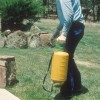 En este documento se describen las medidas que ayudarán en la toma de decisiones inteligentes y seguras sobre la utilización de plaguicidas en el hogar y césped/jardín. This 4-page fact sheet was written by Frederick M. Fishel, and published by the UF Department of Agronomy, December 2012.
En este documento se describen las medidas que ayudarán en la toma de decisiones inteligentes y seguras sobre la utilización de plaguicidas en el hogar y césped/jardín. This 4-page fact sheet was written by Frederick M. Fishel, and published by the UF Department of Agronomy, December 2012.
http://edis.ifas.ufl.edu/pi244
Equipo de Proteccion Personal para la Manipulacion de Pesticidas (PI243)
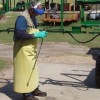 Este documento describe diversos artículos de equipo de protección personal (EPP) que se usan para proteger el cuerpo humano del contacto con pesticidas o residuos de pesticidas. El EPP incluye elementos tales como overoles o trajes protectores, calzado, guantes, delantales, mascarillas, gafas y sombreros. This 12-page fact sheet was written by Frederick Fishel, and published by the UF Department of Agronomy, December 2012.
Este documento describe diversos artículos de equipo de protección personal (EPP) que se usan para proteger el cuerpo humano del contacto con pesticidas o residuos de pesticidas. El EPP incluye elementos tales como overoles o trajes protectores, calzado, guantes, delantales, mascarillas, gafas y sombreros. This 12-page fact sheet was written by Frederick Fishel, and published by the UF Department of Agronomy, December 2012.
http://edis.ifas.ufl.edu/pi243
Fungicide Resistance Action Committee's (FRAC) Classification Scheme of Fungicides According to Mode of Action (PI94/PI131)
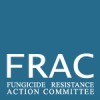 This guide addresses management of pesticide resistance and describes the Fungicide Resistance Action Committee’s (FRAC) classification of fungicides and bactericides registered for agricultural and non-agricultural use in Florida by their modes of action. A cross-reference of common names for active ingredients, along with corresponding examples of their trade names, is also provided. Written by F.M. Fishel and M.M. Dewdney, and published by the UF Department of Agronomy, November 2012.
This guide addresses management of pesticide resistance and describes the Fungicide Resistance Action Committee’s (FRAC) classification of fungicides and bactericides registered for agricultural and non-agricultural use in Florida by their modes of action. A cross-reference of common names for active ingredients, along with corresponding examples of their trade names, is also provided. Written by F.M. Fishel and M.M. Dewdney, and published by the UF Department of Agronomy, November 2012.
http://edis.ifas.ufl.edu/pi131